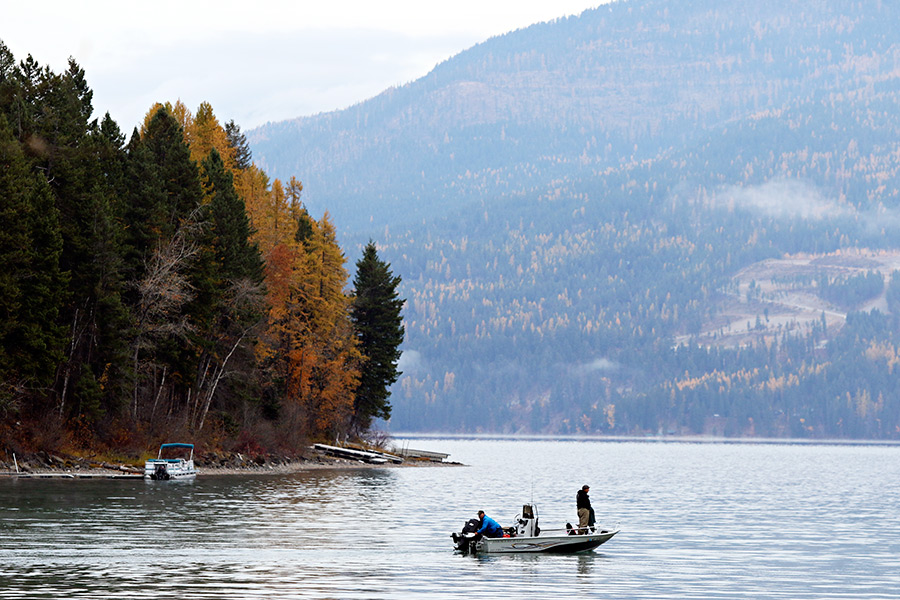A report tracking the history of Whitefish Lake’s water quality says the lake is at a “tipping point” and could be headed in the direction of poorer water quality without continued vigilance and renewed stewardship by local agencies and organizations.
The Whitefish Lake Institute (WLI) on Nov. 16 released its long-awaited “Whitefish Area Water Resources Report: A Status of the Whitefish Lake Watershed and Surrounding Area,” the first comprehensive water quality status report of its kind, and a blueprint that will set the stage for the next ten years of research and management in the watershed.
Relying on historical data and seven years of scientific data collection, the report provides stakeholders with an exhaustive account of the natural and cultural history of the sprawling watershed, and offers a foundation for long-term water quality management.
“This is the only report of its kind for our area,” said Lori Curtis, science and education director for WLI. “It’s sort of a compendium of the resources, and a tool that agencies can use for applying for grants, as well as to identify projects on a priority-based scale.”
The peer-reviewed watershed assessment accomplishes three objectives: It summarizes natural and cultural historical records to describe the watershed; it analyzes WLI’s and other resource management agencies’ data to provide a scientific water-quality assessment; and it provides recommendations to address water-quality issues through restoration and habitat protection; research, education and outreach; and governmental regulations and policy.
“The report points to key time periods in Whitefish Lake’s history and how water quality and the lake’s food web have been affected. Ultimately, a number of research parameters indicate that Whitefish Lake is at a tipping point in water quality,” WLI Executive Director Mike Koopal said. “Like other lake-based communities, clean and healthy water is one of the chief assets driving economic demand in the Whitefish area. Community leaders, resource managers and citizens have become increasingly aware of the long-term impacts of human development activities on the health of the watershed. It is clear that investing in and protecting our natural assets is not only good for people, wildlife, and natural resources, but it also makes financial sense.”
With a suite of water quality issues and choices slated to come before citizens and resource managers over the next several years, Koopal said it will be important to make decisions with long-term water quality and community economics in mind.
“The cost to the community in loss of property value and visitor revenue, coupled with loss of ecosystem function is real,” Koopal said.
According to the report, nature-based tourism accounts for roughly 20 percent of the $7.8 billion annual economy of Flathead and Lake counties, and ecological services contributes another $20 billion. The cost for repairing ecological damage – when it can be repaired – such as in Lake Tahoe on the California-Nevada border has been $1.4 billion since the 1960s of which $415 million was spent since 2010.
Because the Whitefish Lake watershed is nestled in the larger Flathead Lake watershed, encompassing more than 6 million acres of land and water, which is in turn part of the Columbia River Basin, the decisions made on a local level will have broad impacts elsewhere.
“If you are standing on the beach in Astoria, Oregon, the water that you’re looking at in the Pacific Ocean came from the Flathead watershed,” Curtis said. “So we are responsible for and affect so many watersheds below us that it is really imperative that people in this watershed pay attention to what they do not only for us, but for the environment and the economies below us.”
Whitefish Mayor John Muhlfeld said the city is already taking steps to address the problem of septic leachate in Whitefish Lake, and develop a nutrient trading program with incentives to replace outmoded septic systems. However, he noted that it will require broad cooperation from local government and understanding by residents and voters.
“This excellent study confirms what we have all suspected is happening to Whitefish Lake. What needs to happen now is a focus on action items that will produce tangible results for water quality,” Muhlfeld said. “Whitefish is taking progressive steps by addressing septic leachate and developing a nutrient trading program. But it takes cooperation, and very little of our planning jurisdiction includes the lake. That is why it is so important for our county commissioners to become engaged in the work we are doing to protect one of the greatest economic assets to Whitefish and Flathead County.”
The report was funded through a planning grant by the Montana Department of Natural Resources and Conservation, with contributions from the Whitefish Community Foundation’s annual grant program, and the Whitefish County Water District.
The full report is available for download at http://whitefishlake.org/download/
